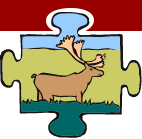BIRDS (OTHER WILDLIFE - AVIAN)
Indicators
- Population size and trend
- Number harvested
- Distribution and abundance
- Rate of breeding success
- Presence of diseases and parasites
- Age structure
- Habitat quality
- Food availability
- Presence of contaminants
|
Current Knowledge
There are over 235 species of birds that migrate through or live in the NWT. The majority of those birds spend only the breeding season in the NWT. Increased levels of development in the NWT are of concern for loss of bird habitat. The potential effects of climate change on habitat and distribution are also a concern. The four main categories of avian wildlife waterfowl, waterbirds, shorebirds and landbirds- are all found throughout the NWT.
Waterfowl and waterbirds are abundant and widespread in the NWT; however baseline information on these species is generally lacking. Shorebirds include species like sandpipers and plovers; they are widespread in the NWT but baseline information is lacking. There appears to be a negative population trend in shorebird species. In the NWT, the Eskimo curlew is an endangered species. Landbirds include songbirds, woodpeckers, owls and raptors; information about these species is varied.
Contaminant levels in aquatic birds were studied in the late 1980s/early 1990s study and levels of contaminants in harvested birds were found to be low. Predatory and scavenging birds however, may have higher levels. There is no regular program to monitor contaminants in birds.
Current Monitoring
- Proposed ongoing species - specific or area specific research near Fort Simpson, Norman Wells, and Colville Lake EC-CWS
- Biological assessments of landbirds at Edehzie, Tsudehliline-Tuyetah at Protected Areas PAS Secretariat, INAC>
- NWT / Nunavut bird checklist survey Canadian Wildlife Service (CWS)
- North American breeding bird survey CWS
- Christmas bird counts volunteer-based
- NWT species status rank infobase Government of the Northwest Territories (GNWT)
- Wildlife effects monitoring program - BHP Diamonds, Inc.
- Migratory bird and wildlife monitoring program for Fort Liard development project - Shiha Energy Transmission Ltd.
- Bird monitoring along Chevron pipeline right-of-way, Fort Liard Chevron Ltd.
- Gwich'in Settlement Area harvest study - Gwich'in Renewable Resources Board (RRB)
- Sahtu Settlement Area harvest study - Sahtu RRB
- Inuvialuit Settlement Region harvest study - Inuvialuit Joint Secretariat
- Duck banding projects US Fish and Wildlife Service (USFWS), GNWT, CWS
- Gwich'in Territorial Park waterfowl survey - Gwich'in RRB
- Snow Goose Inventory: Western Arctic CWS
- Populations and habitat of waterfowl and other aquatic birds in the Inuvialuit Settlement Region CWS
- Evaluation effects of gas and oil development using tundra swans as an indicator species - CWS
- Population ecology of lesser scaup in boreal forest CWS
- Ecology of horned and red-necked grebes CWS
- Productivity of boreal forest duck and grebe populations CWS
- Annual spring aerial survey of waterfowl breeding areas in North America - USFWS, CWS
- Five-years surveys of Trumpeter swans CWS
- Arctic shorebirds monitoring program CWS
- Program for Regional and International Shorebird Monitoring (PRISM)
- Distribution and abundance of forest songbirds in different habitats CWS
- Ecology of Whooping Cranes CWS
- Five-year Peregrine Falcon Surveys GNWT
- Raptor monitoring at Daring Lake GNWT
- Raptor monitoring - Diavik Diamond Mines Inc.
Gaps and Recommendations
Little is known about the distribution, population size, breeding success and condition / health for most types of birds. In particular, we know little about birds whose populations are declining.
The funds available for monitoring are not steady from year to year, so monitoring is not consistent. Methods of surveying birds along roads are not suitable for the NWT. Many regions have never been surveyed for birds of prey.
There needs to be long-term monitoring of the distribution, population size and breeding success for particular species, especially those whose numbers are declining. We need to determine changes in bird communities in relation to climate change. New information is needed on contaminant levels in birds. Community-based monitoring programs are needed for: when birds arrive, nest and leave; the distribution of birds; and their reproductive success for both game and non-game types. Community-based monitoring of bird condition and health is needed for game species.
Source: A Preliminary State of Knowledge of Valued Components for the NWT Cumulative Impact Monitoring Program (NWT CIMP) and Audit - Final Draft. February 2002; updated February 2005 and June 2007.
For more details, you may also want to look at:
-
Birds Excerpt
-
VC State of Knowledge Full Report
-
Projects on Birds and Insects
- NWT Environmental Audit 2005 - Supplementary Report on the Status of the Environment
Top of page


